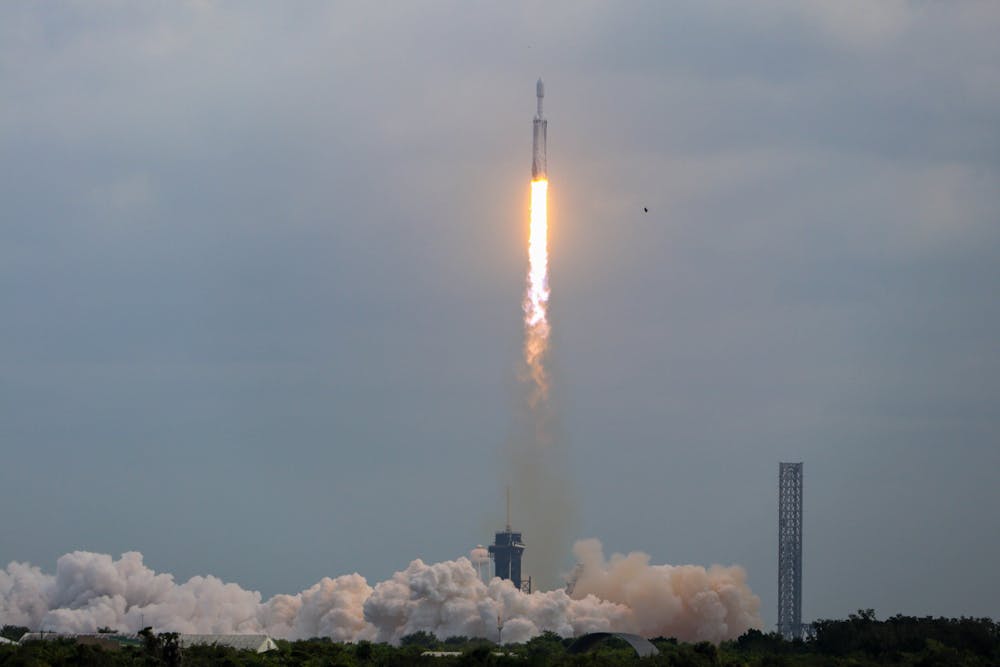Looking across the water, the SpaceX Falcon Heavy rocket stood ready for launch Friday morning, carrying the Psyche satellite. The timer, counting down the time until launch, built anticipation with every moment it neared closer to zero.
Principal investigator Lindy Elkins-Tanton, a foundation and regents professor at the School Of Earth and Space Exploration, led the collaboration between ASU, the Jet Propulsion Lab and NASA.
While just one of a host of revolutionary instruments on board, an ASU team is also responsible for the Psyche Multispectral Imager. This set of specialized cameras will be used to study the geology, topography and composition of the 16 Psyche asteroid.
Despite two major delays, the weather percent go – which determines launch likelihood due to weather – increased from 40% on Thursday morning to 60% on Friday morning, and the launch process was initiated.
READ MORE: NASA Psyche Mission set to launch in 2023 with new flight plan
7:01 a.m. EST (T - 3:17:49): The State Press arrives at the Kennedy Space Center media site. Media equipment is set up and a State Press home base is set up for constant communication and updates.
7:29 a.m. (T - 2:47:00): The sunrise can be seen over launch pad 39A. The fog begins to burn away, but still covers the sun.
8:30 a.m. (T - 1:49:06): The weather percent go increases to 85%. There is now only a 15% chance that weather will delay the launch.
9:40 a.m. (T - 39:00): Every journalist, photographer and social media creator congregates in the outdoor viewing field, with a strong sense of excitement and community building among the viewers.
9:31 a.m. (T - 30:00): The public NASA stream of the launch begins online and starts broadcasting over the viewing field.
9:57 a.m. (T - 22:00): Fallout, in the form of gray clouds of steam, exits the side of the rocket. The clouds billow out, ending up at around half of the rocket's height. This is the point of no return, because fuel is being actively spent.
10:16:09 a.m. (T - 3:34): The NASA media representative team exits the press room and joins the viewing field.
10:17:52 a.m. (T - 1:51): More gray fallout drifts from the rocket in immediate preparation for launch.
10:19:43 a.m. (T - 0:00): Liftoff begins. Gray smoke erupts from the boosters. Falcon Heavy lifts off from the tower with a bright streak of orange exhaust flame, flying straight up. While the rocket flies through clouds, the exhaust flame remains bright and visible.
10:20:31 a.m. (T + 00:00:48): The rumbling and popping sound of the rocket reaches the viewing field and quickly grows in intensity, along with a booming sonic force.
10:21:04 a.m. (T + 00:01:21): A smoke trail can be visible against the cloud cover as the rocket flies higher into the sky.
10:21:38 a.m. (T + 00:01:55): The rocket and exhaust flame are no longer visible from the viewing field.
10:24:06 a.m. (T + 00:04:23): The rumbling and popping of the rocket can still be heard from the sky clearly.
10:27:21 a.m. (T + 00:07:38): Puffs of smoke appear as the boosters detach from the rocket, though they are not visible against the sun.
10: 28:17 a.m. (T + 00:08:34): The first sonic boom can be heard from the viewing field. It is accompanied by a whistling sound coming from the sonic booms echoing against the Vehicle Assembly Building, which strangely appears to come from the opposite direction.
10:28:29 a.m. (T + 00:08:46): The second sonic boom can be heard, again accompanied by a whistling sound.
11:22 am (T+ 1:02:19): Psyche separates from the rocket, and begins its six-year journey into deep space. While liftoff is confirmed immediately, the launch is officially declared when the satellite safely detaches from the rocket.
With launch confirmed, Psyche is expected to reach the 16 Psyche asteroid in 2029 and begin its first orbit and data collection.
Edited by Sadie Buggle and Shane Brennan
Reach the reporters at syramir2@asu.edu and asgrazia@asu.edu and follow @nerdyoso and @emphasisonno on X.
Like The State Press on Facebook and follow @statepress on X.
River is a senior studying english and mechanical engineering. This is their fourth semester with The State Press.
Sophia is a senior studying biological sciences. This is her fifth semester with The State Press. She has also worked as a science and technology reporter.




